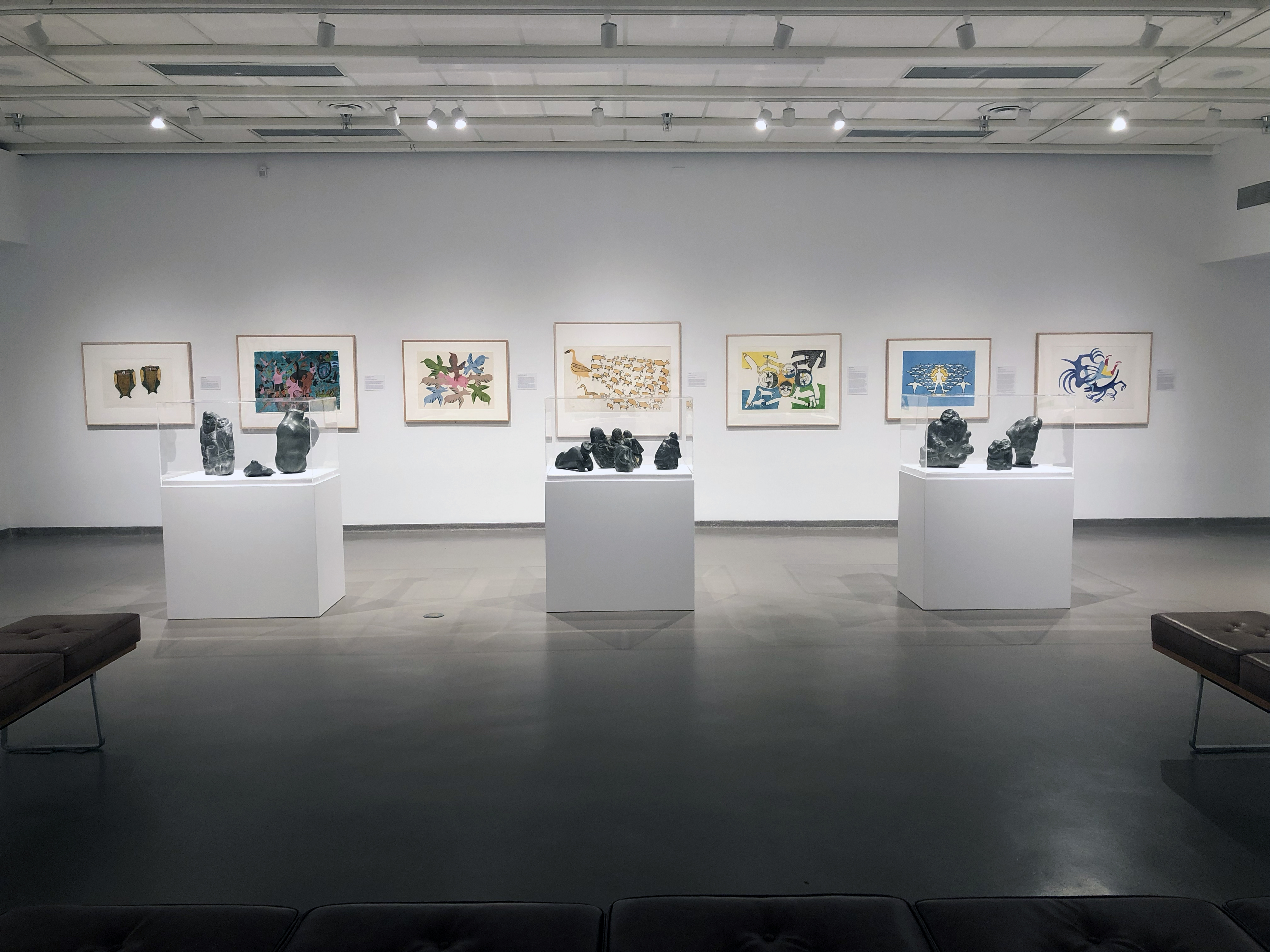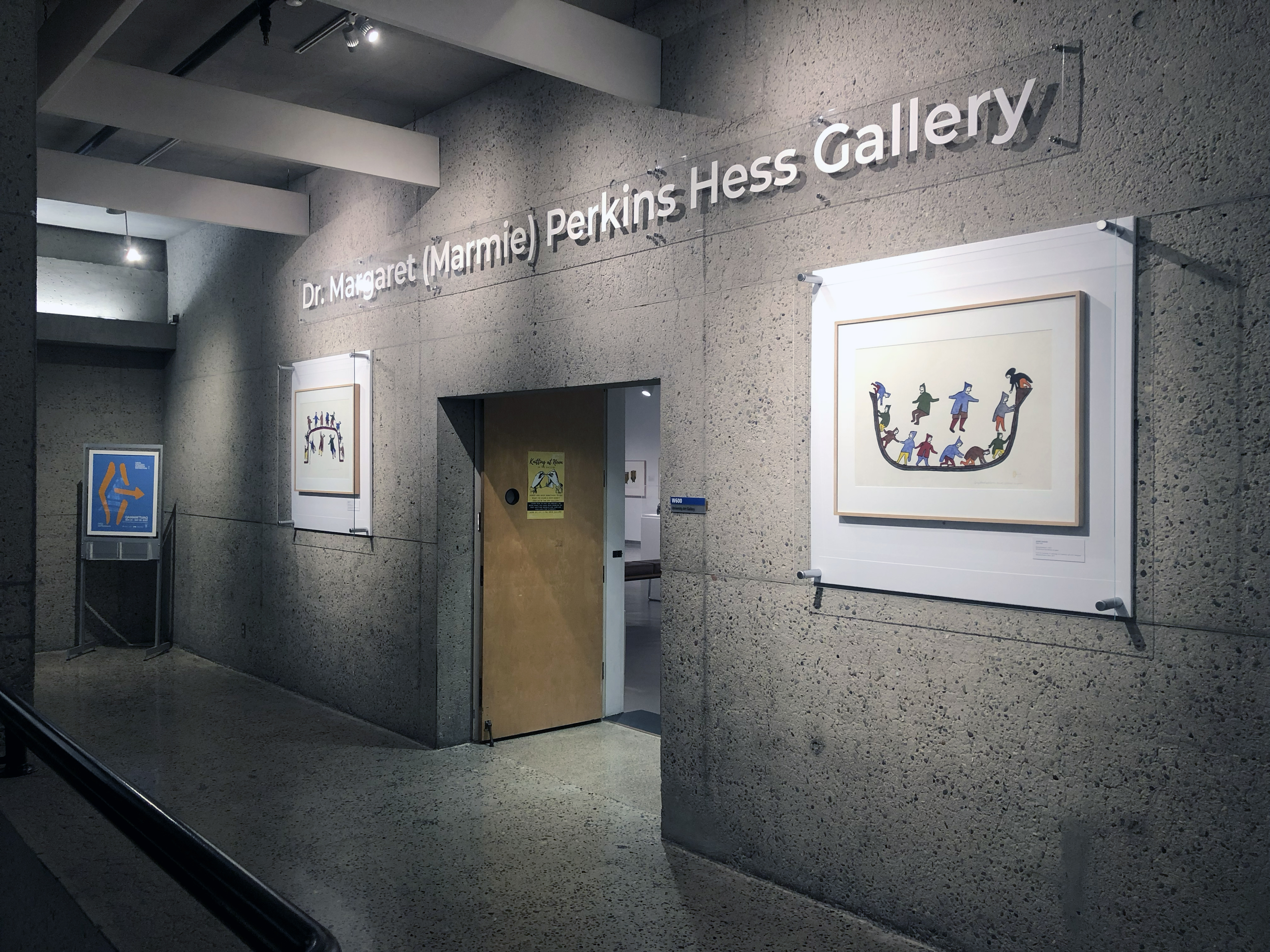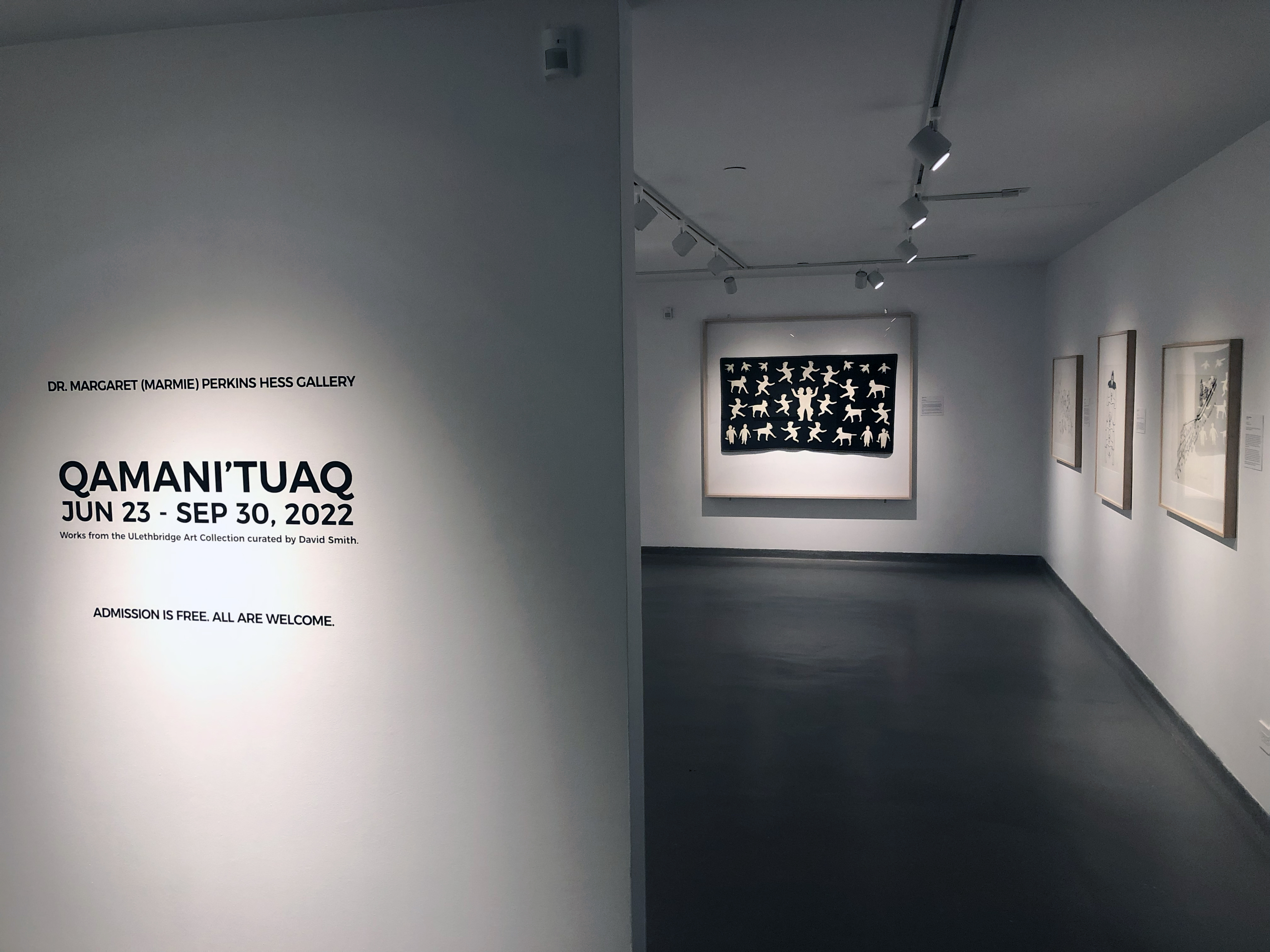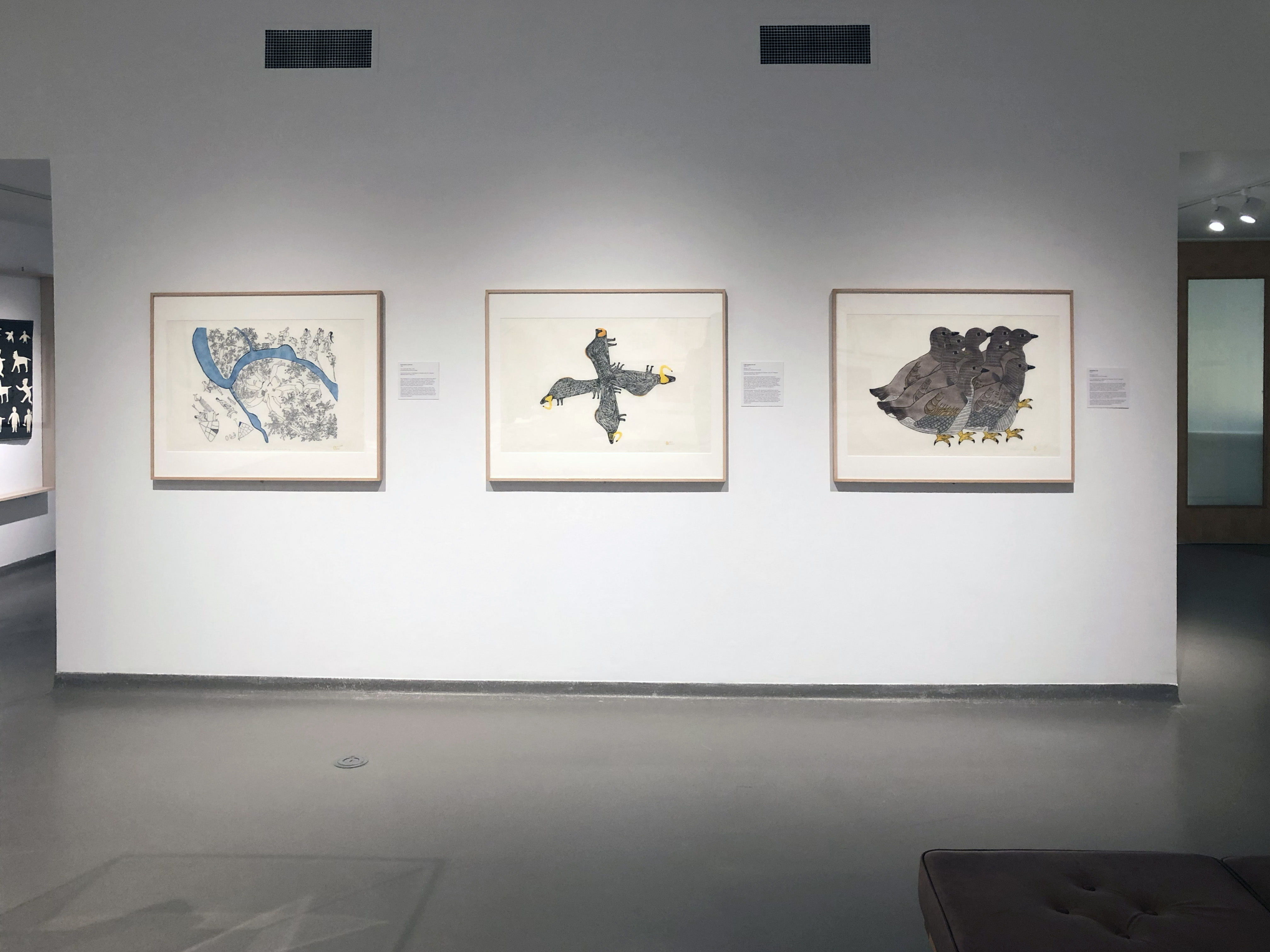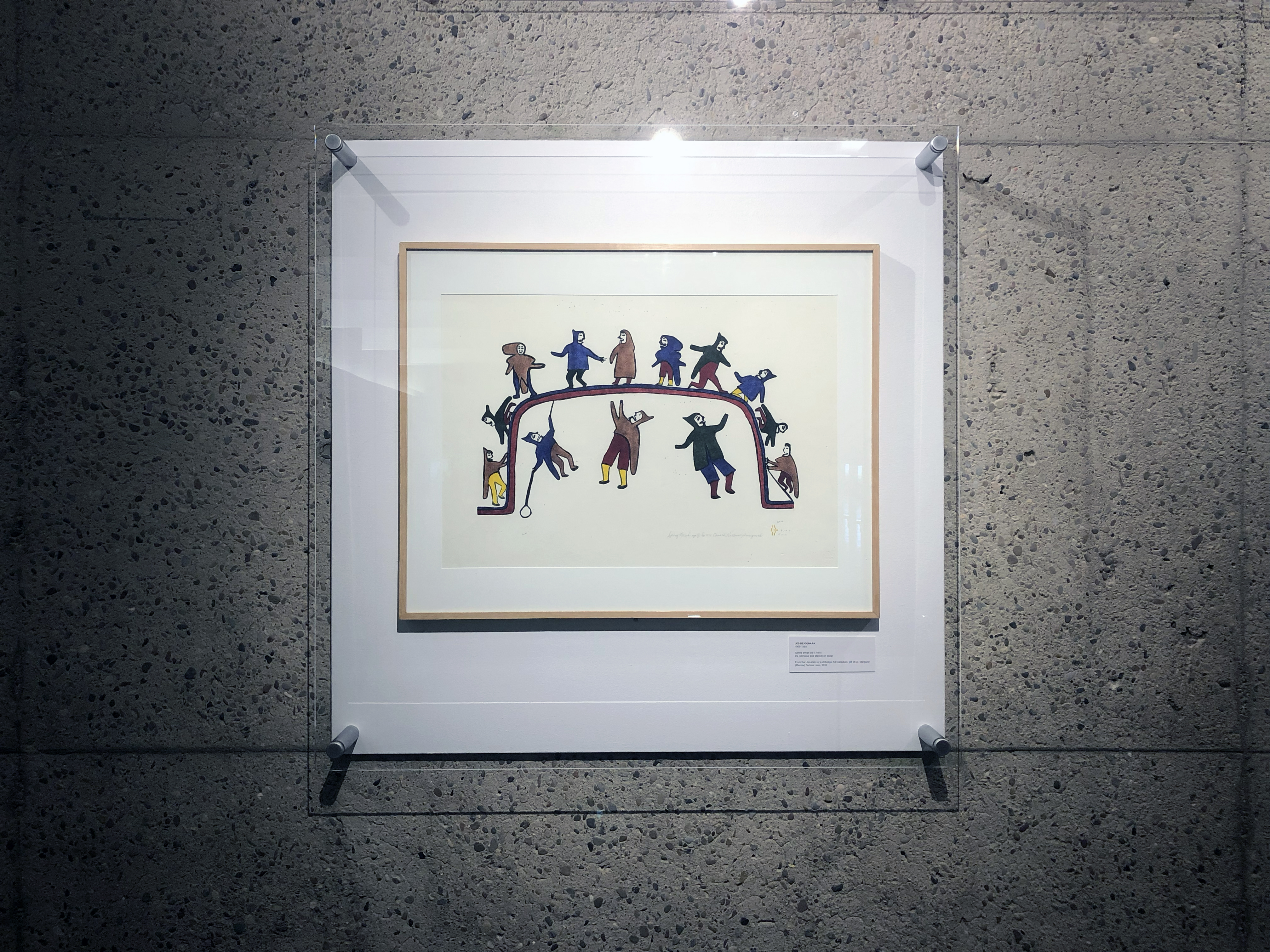Dr. Margaret (Marmie) Perkins Hess Gallery
Qamani’tuaq
June 23 – September 28, 2022
Works from the ULethbridge Art Collection curated by David Smith.
Curatorial Statement
Qamani’tuaq is the Inuktitut name for the community known as Baker Lake and means “huge lake adjoined by a river at both ends”.[1] Located 320km west of the coast of Hudson Bay, in the Territory of Nunavut (one of the four regions that make up Inuit Nunangat), it is the closest permanent settlement to the geographic center of Canada.
Colonial practices in this region established a reliance for the Inuit people on the economy of the fur trade. This imposed a transition from a nomadic lifestyle that followed herds of caribou, to one of permanent settlements built around trading posts. When the fur trade collapsed in the 1940s and 50s, alongside a decline in caribou populations, the Canadian government responded by building facilities for medical, education and social services at several arctic trading posts including Qamani’tuaq.[2] Today this community has a population of just over two-thousand and is home to eleven distinct Inuit groups.
Another federal government in the 1950s was the establishment of co-operatives in some northern communities to encourage production of arts and crafts (among many other things). One of the most successful ventures of the co-ops was the production of annual limited edition print portfolios. The first released portfolio was from Kinngait (Cape Dorset) in 1959, while the Sanavik Co-operative in Qamani’tuaq began a decade later when it released its first print collection. Both co-ops are in operation today and Kinggait is the only community which continues to produce annual print portfolios.
Prints from each co-op are distinguishable from one another by the chops (or stamps) which are unique to the co-op. The Sanavik chop serves as the inspiration for the poster design for this exhibition and can be seen on each of the prints included. With content derived from oral tradition, imagination and sometimes other artwork such as textiles, the bold prints produced here were usually made from stonecuts and often combined with stencils which enabled the use of many colours in one print.[3] Stonecuts produce solid distinct lines and often use darker colours, while stencils create areas of colour which may have subtle variations in tone or use multiple overlapping layers. In this exhibition Simon Tookoome’s A Vision of Animals (1972) and many others, combine the two techniques within a single print.
Qamani’tuaq artists are particularly well-known for their textile wall hangings. This medium provides much more flexibility than prints because the artists are not restricted by size or shape. Sometimes the textiles are wall-sized or use shapes inspired by seal skin pelts. Curator Krista Ulujuk Zawadski has described the cultural importance of the practice:
Sewing for Inuit has always been the basis of our culture, our roots and our worldview. Sewing nourishes our lives with warm clothing, it strengthens our traditions by providing opportunities to share knowledge and opens an avenue for meaningful memory-making with our families. Sewing provides a way for transmitting our culture, stories and values to younger generations—threading our lives together in the intergenerational tapestry of Inuit life. Sewing is a cornerstone of our language, culture and values; it has been, and still is, a strong component of our lives.[4]
Some artists from this region are better-known for their textile work than any other medium. Jessie Oonark’s work in textile, for example, occasionally shows up in her prints in pieces such as High Play, 1972, which is based on a wall hanging by the same name in the collection of the Winnipeg Art Gallery. Though the Qamani’tuaq textiles stylistically vary from one artist to another, Winnie Tatya’s undated Wall hanging in this exhibition demonstrates, through her dynamic yet symmetrical composition, the precise and fine needlework for which these textiles are known.
Like artists from other communities in the north, Qamani’tuaq artists carved stone sculpture as well. The type of stone available in the region is a very hard basalt which is dark grey to black in colour. When artists began carving in the late 1950s and early 1960s they had a great deal of autonomy with their practice. When the Federal arts and crafts program was introduced in 1966 however, factors from outside the community – commercial demand and mentorship from various craft officers – began to influence some of the characteristics of carving from this region.[5] Eventually, works that emerged became monolithic and large in size, rounded but not highly polished, and utilized narrative to great effect.[6] Family Group (undated) by sculptor Barnabus Akkanashoonark is a particularly striking example. The complex group of figures has an inherent story and the dark basalt and surface treatment are telltale clues of its genesis in the community.
In 2017 the U of L Art Gallery received a bequest from the estate of Dr. Margaret (Marmie) Perkins Hess which included more than six hundred Inuit prints. Approximately one hundred of them were from Qamani’tuaq and, in fact, doubled the university’s holdings of work from this community. The gift also contained work by twelve artists from Qamani’tuaq not previously represented in the collection. Dr. Hess opened and operated a commercial gallery (Calgary Galleries Ltd.) through the 1970s, and it was one of the first galleries in Canada promoting work by Indigenous artists. To celebrate her generous gift, our U of L Art Gallery was named in her honour.
David Smith
Assistant Curator / Preparator
[1] Keith Darren. “Baker Lake,” Nunavut Hand Book, 2004, pg. 94.
[2] Jennifer Alsop. “Development of the Community of Baker Lake,” The History of the Baker Lake (Sanavik) Co
-operative, 2010.
[3] Kyra Vladykov Fisher, “The Baker Lake Printmaking Revival,” ARCTIC 50, no. 2 (June 1997): pp. 192-196.
[4] Krista Ulujuk Zawadski, “The Traditional Knowledge Hidden in Qamani’Tuaq’s Wallhangings,” Inuit Art
Quarterly 33, no. 1 (June 1, 2022), https://www.inuitartfoundation.org/iaq-online/threading-memories.
[5] Marie Bouchard, “Inventing Inuit Art,” in An Inuit Perspective – Baker Lake Sculpture (Itsarnittakarvik: Inuit
Heritage Centre, 2000), pp. 25-31, 29.
[6] Bouchard, 29.



